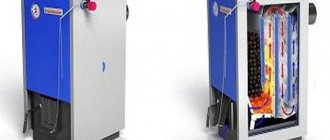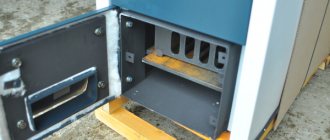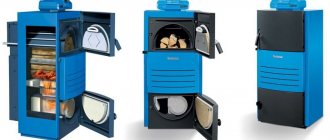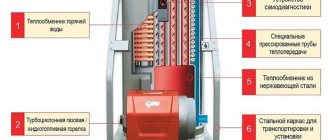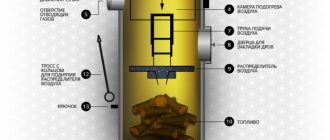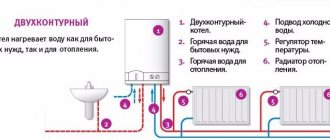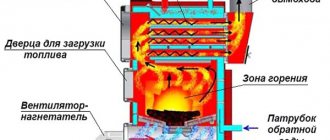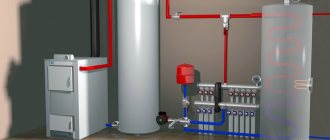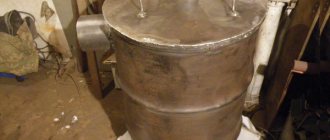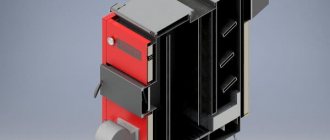The heating system is one of the important communications of the building. Every year, manufacturers offer consumers new models of units. To choose the best solid fuel heating boilers, you need to take into account their power, efficiency value and type of control. For example, the presence of an automatic ignition function will significantly simplify operation.
The equipment designed for the heating system of a private home is a very effective solution. Heating with electricity is associated with high costs. If it is necessary to heat a large area, then gas devices in this case will be more economical, but it is not always possible to provide the house with the appropriate fuel.
Solid fuel boilers for heating a private house
Heating a country house of any type primarily tends to use equipment that does not depend on expensive energy sources. With the development of technology for the production of solid fuel boilers for heating private houses, which can now provide heat for a long time from one filling, they have become effective, economical and convenient when compared with other types of heating equipment.
Gas boiler for heating a private house: types and features of various types (read more)
The use of solid fuel boilers for heating private houses has become in demand again.
The solid fuel heating boiler operates on wood, coal, coke, peat, pellets, briquettes, granules, and utilizes woodworking and agricultural waste. The environmentally friendly heat generator does not depend on centralized gas and electricity supplies. Combined models improve the quality of the main or backup source, increase efficiency, and reduce the cost of the heating system.
Design features of solid fuel boilers
Material for the manufacture of units: cast iron or high-strength boiler steel. The properties of materials influence the service life and thermal inertness of the structure. Steel boilers have a high resistance to deformation due to changes in pressure and temperature. Cast iron is resistant to corrosion.
Advantages of steel boilers: reasonable price, aesthetic appearance, convenient loading. Advantages of equipment made of cast iron: ease of operation (do not require special preparation of boiler water), durability, ability to transfer heat for a long time.
Burner of a pellet boiler - cross-sectional view.
Cast iron units are chosen for houses with permanent residence. For dachas and country houses with occasional residence, steel boilers are used.
The complete set of heat generators is divided into single- or double-circuit versions. One circuit ensures the operation of a solid fuel boiler for heating a private home. Two independent rings allow you to heat the room and supply hot water.
The energy dependence is due to the equipment of the unit with a forced air supply system for combustion or automated fuel loading.
Various raw material options for use in solid fuel boilers.
Based on the fuel combustion time, a distinction is made between traditional and pyrolysis heating boilers. Gas generators provide long-term decomposition of fuel with the release of heat, which occurs when there is a lack of oxygen. Some models provide for loading long-burning solid fuel boilers once a week.
Pyrolysis boilers are in demand by consumers due to their energy independence, economical fuel consumption, environmental friendliness and high efficiency.
Pyrolysis boiler with automatic fuel supply (pellets).
Difference between manual and automatic loading of boilers
When comparing solid fuel boilers, one should also not miss such a parameter as their loading mechanism, which can be of two types: automatic and manual.
The design of boilers with automatic fuel supply is based on the main part and a special bunker, into which the fuel is placed directly (for more details: “What are the types of automatic solid fuel boilers - types, features, installation rules”). If it is coal, then the size of its particles should not exceed 25 mm. However, there is also the possibility of using pellets, which definitely do not exceed this parameter.
For continuous and high-quality operation, one load of fuel is enough for approximately three to five days, which makes working with the boiler very convenient and easy.
At the same time, the size of the boiler bunker can be very different, it all depends solely on the preferences of the owners, since you can load a lot of consumables into this chamber, thereby forgetting for a long time about the need to replenish the coolant supply in the boiler.
Fuel is supplied through one of two options - either using a screw or using a piston. Regardless of this, we can say with confidence that the most economical solid fuel boiler will definitely have an automatic fuel supply mechanism, which will not only prevent excessive material consumption, but will also be able to guarantee stable operating power of the equipment.
Manual loading is more familiar to consumers and involves filling the boiler chamber with fuel themselves. Many owners are well aware of how a solid fuel boiler of this type works, as they have often encountered them in traditional rural homes. Such boilers can operate on any material (coal, sawdust, peat, etc.). About
Advantages of using solid fuel boilers
The benefits of using a long-term heat-producing solid fuel boiler for heating a private home are valuable in that already at the installation stage it eliminates the most difficult and expensive tasks. Just connecting a house to gas costs users much more than the cost of any solid fuel equipment. And if you consider that for this money you can buy a boiler that produces heat for half a day from one load of solid inexpensive fuel, then such equipment completely pays for itself in one fuel season. A TT boiler allows you to relieve yourself of the burden of paying for constantly rising gas prices.
Scheme of operation of a solid fuel boiler.
A solid fuel boiler for heating can be loaded with all available types of fuel: wood, peat, coal. Recently, the use of special pellets made from wood sawdust or straw as solid fuel has become increasingly popular. Such an environmentally friendly, clean source of energy in itself is capable of providing even higher efficiency of thermal energy output. Maintenance of modern fuel equipment does not require time or frequent maintenance. It is enough to load it with fuel several times a day (this depends on the type of boiler).
Solid fuel boilers can operate on wood, coal or special fuel granules (pellets).
Equipment for solid fuel boilers: buffer tank
The operation of solid fuel equipment is always associated with a certain cyclicity - peak production of thermal energy, even in excess quantities, during the main phase of fuel combustion, with a gradual decrease to almost zero during periods of inactivity.
Constantly replenishing fuel in the boiler is inconvenient for a number of reasons, it is unprofitable, and in many models it is completely technologically impossible.
Is it possible to make sure that the efficiency of the heating system does not suffer from this pronounced unevenness of energy supply, so that during the burning of the fuel fill a reserve of excess heat is created, which can then be usefully used, and not “thrown down the drain”?
Yes, this is quite possible - a similar problem is successfully solved by a buffer tank for a solid fuel boiler.
A buffer tank (heat accumulator, storage tank) is a device that accumulates and stores heat.
It looks like a huge thermos, in the form of a cylindrical tank with insulated walls. Its height is several times greater than its volume. The tank is insulated with heat-resistant foam, which helps retain and maintain heat inside the tank.
The heat accumulator is the main element in heating and heat distribution throughout the room. Its main task is to receive and accumulate thermal energy from different heat sources (solid fuel or electric boiler), and then rational distribution throughout the heating system and water supply.
The high efficiency of the buffer tank is due to the fact that it is able to accumulate and retain heat (a certain amount), and then gradually release it. In a nutshell, a buffer tank is a kind of thermos, a barrel made of metal (sometimes insulated) with a volume of 200 to 7000 liters.
The main element of the buffer tank is a thermal storage material that retains and distributes the heat supply.
Depending on the material used, the heat accumulator can be divided into several types:
- liquid;
- solid state;
- thermochemical;
- steam;
- with additional heating elements.
Let us pay attention to the operation of the heat accumulator using a solid fuel boiler.
In the pipeline between the boiler and the heat accumulator, there is a circulation pump, which starts, and this is how the system begins to work.
From the lower half of the tank, cooled water moves to the boiler, where it is heated. Once heated to the desired temperature, the liquid moves to the top of the container. Hot water is located at the top of the tank, and with the help of a pump, the liquid that is located below is pumped into the boiler.
When the circulation pump, which is installed in the return line of the system, is turned on, cold water slowly flows into the lower half of the buffer tank.
Subsequently, hot water is forced out of the tank and sent to the heating system. After the fuel boiler stops operating, heat from the buffer tank continues to be supplied to the system until cold liquid from the line fills the internal volume of the tank.
The operating time of the heat accumulator, after stopping the boiler, depends on the outside air temperature, the volume of the tank and the number of heating devices.
The buffer tank is a unique invention that provides heat to the home and helps save money.
A buffer tank is a metal barrel with insulation with a volume of 200 liters or more, installed between the source of thermal energy and the heating system of the house as a separator of thermal circuits with different temperatures and a heat storage device.
A storage tank is necessary if several different sources of thermal energy are combined into one system: gas, solid fuel, electric boilers, heat pump and solar collector.
The heat accumulator collects heat at any time during operation of each source. For example, during the day - from a solar collector, at night - from a heat pump or electric boiler, at any time when a gas or solid fuel boiler is operating.
Heat is distributed continuously. Connecting a buffer tank to the thermal energy transfer circuit increases the operating efficiency of the solid fuel boiler itself due to the collection and accumulation of heat. This allows you to eliminate idle heat energy consumption from the system.
If the temperature in the buffer tank drops, does this mean that the boiler needs to be fired up again? In the case of a system without a buffer tank, the temperature begins to drop immediately and this drop begins to be felt by a person after 0.5 - 3 hours (depending on the temperature outside, insulation of the house, etc.).
In a scheme with a buffer tank, the amount of water in the system increases (depending on the volume of the buffer from 500 liters to 2000 or more).
Accordingly, this volume of water will cool down several times slower. So it turns out that you will feel the cooling after stopping the boiler not after 0.5-3 hours, but after about 6-24 hours.
Here are the real benefits and savings. This is the time when you don’t have to heat the boiler.
Most types of solid fuel have three combustion phases - flare-up, intense combustion and decay. During intense combustion, the fuel gives off more heat than is required by the system, but the initial and final phases, on the contrary, do not provide enough heat.
When using such fuel, there are often large temperature changes in the house, and a comfortable climate for life is formed rarely and accidentally.
The buffer capacity is designed to smooth out these irregularities. Thanks to it, without any effort or additional equipment, you can always see your favorite +22, +25 or any other number that is comfortable for you on the thermometer.
During the intense combustion phase, the container absorbs excess heat, and after the boiler dies out, it continues to release heat into the heating system.
This allows you not only to maintain the desired temperature in the room, but also save up to 50% of energy. The buffer tank works in exactly the same way in combination with a heat pump, only in this case it accumulates cold, not heat.
The storage tank has another important function. If you have more than one heating device installed in your system, you can connect them to one buffer tank.
Thanks to this you can:
- abandon unnecessary parts of the system;
- configure heating devices to operate according to priority;
- avoid unnecessary switching on of some devices or switching off of others.
Advantages and disadvantages of using a buffer tank
There are many reasons why you should use this design:
- Boiler operating schedule.
Solid fuel boilers must be regularly equipped with fuel. At night, such a process is completely inconvenient, and in this case the heat accumulator saves the day. Warm water is stored in a buffer tank. And then it spreads throughout the system.
Installing a heat accumulator allows you to increase the intervals between firing the boiler and will help to significantly reduce fuel consumption.
- If an electric boiler is used, savings occur at night.
Since the cost of electricity differs several times during the day and at night. Installing a buffer tank will allow you to program the boiler to operate only during night operation.
- Uneven heat supply.
Almost all boilers have three phases of operation: flare-up, intense combustion and decay. Due to this process, strong temperature changes occur. A buffer tank will help avoid this phenomenon.
During the period of intense combustion, the tank absorbs excess heat, and during extinction it gradually releases it into the heating system.
- Mechanical regulation of the boiler operation prevents the combustion of all harmful substances.
During operation of solid fuel boilers, harmful substances (acids, tar) are released. Standard boilers are equipped with an air valve, which blocks the supply of oxygen to the fuel and provokes the release of harmful substances.
By installing a buffer tank, you can not only provide your home with heat, but also maintain your health and reduce the amount of harmful emissions into the atmosphere.
- Overheat protection.
Working intensively, the boiler may overheat, which will lead to disastrous consequences (system failure, explosion). The heat accumulator reliably protects the boiler installation and heating system from overheating.
- Saving.
By installing a thermal accumulator you can save up to 30% of fuel and electricity.
The advantages of autonomous solid fuel heating systems with a heat accumulator include the following:
- The energy potential of solid fuel is used to the maximum extent possible. Accordingly, the efficiency of boiler equipment increases sharply.
- The operation of the system will require much less human intervention - from reducing the number of boiler loadings with fuel to expanding the ability to automate the control of operating modes of various heating circuits.
- The solid fuel boiler itself receives reliable protection against overheating.
- The operation of the system becomes smoother and more predictable, providing a differentiated approach to heating different rooms.
- There are ample opportunities to modernize the system, including the launch of additional sources of thermal energy, without dismantling the old ones.
- In most cases, the problem of hot water supply at home is also solved.
There are also a number of disadvantages:
- A heating system equipped with a buffer tank is characterized by very high inertia. This means that from the moment of initial ignition of the boiler until reaching the nominal operating mode it will take quite a lot of time.
This is unlikely to be justified in a country house, which in winter the owners visit only on weekends - in such situations, rapid heating is required.
- Heat accumulators are bulky and heavy (especially when filled with water) structures.
They require enough space and a well-prepared, reliable foundation. Moreover, it is close to the heating boiler.
This is not possible in every boiler room. Plus, there are difficulties with delivery and unloading, and often also with bringing the container into the room (it may not fit through the door). All this should be taken into account in advance.
- The disadvantages include the very high price of such devices, which sometimes even exceeds the cost of the boiler. This “minus”, however, brightens up the expected saving effect from more rational use of fuel.
- The heat accumulator will fully reveal its positive qualities only if the rated power of the solid fuel boiler (or the total power of other heat sources) is at least twice as high as the calculated value required for effective heating of the house.
Otherwise, purchasing a buffer capacity seems unprofitable.
Conventional solid fuel boilers
If we talk about this type of fuel equipment, then these are traditional boilers that have a simple design. The fuel burns in the usual way, heating water, which transfers heat throughout the house. The advantage is that the price of a solid fuel boiler for heating a private house will be low. Among the disadvantages are the following: loss of released energy, the need to frequently add fuel.
The modern design of solid fuel boilers will allow them to fit into any living space.
If earlier, when the technologies of efficient fuel boilers were not yet used for private use, this was the most used equipment. Currently, it can be purchased for country houses where short-term stays are planned during the cold season.
Firewood is an affordable and economical type of fuel.
Pyrolysis heating boilers
The design of solid fuel boilers for heating a private house of the pyrolysis type has its own characteristics. The tank where the fuel is burned is divided into two parts. The chamber where solid materials are loaded is located in the upper half. The air supply is regulated in such a way that it is sufficient to support the smoldering process of the fuel. As a result, gas is released, which can also burn. He goes to the lower chamber. The combustion efficiency of a pyrolysis boiler increases by 80-90%, and the burning time of one fill can reach up to 12 hours.
Long-burning pyrolysis boiler: advantages and disadvantages (read more)
Design of a pyrolysis solid fuel boiler.
The compartment in which the gases are burned must withstand high temperatures. Therefore, it is made using heat-resistant materials. After fuel combustion in pyrolysis colas, there is practically no ash and soot left. The complex design, the need to use special materials, install a smoke exhauster, and electronic control systems mean that the price of solid fuel boilers for heating a private home is much more expensive than classic ones. But the benefits speak for themselves.
Stages of operation of a solid fuel pyrolysis boiler.
Despite the high cost, pyrolysis boilers do not repel buyers. They know how to count money and can determine the benefits that will pay off all costs in the short term. Therefore, the present and future in the process of organizing heating of private houses is associated with pyrolysis boilers.
Types of boilers, their differences
There are several types of solid fuel boilers:
- Classic is a type of heat generator that uses coal and wood as fuel. Fuel loading is done manually. It has the following advantages: many models do not depend on electricity, safety is high, fuel is cheap, easy to use, and efficiency is good. Disadvantages: such a boiler is installed in a separate room, you need a place to store fuel (coal, firewood), you constantly need to clean and load it.
- Pyrolysis boilers are a modernized classic boiler. There are two chambers that are connected by ceramic nozzles. The first chamber is used for firewood, which heats up at high temperatures and turns into coal and gas. The second chamber is needed to receive pyrolysis gas. The advantages of such a boiler: high performance, the time between loading increases, can be used together with a boiler, there is an option to automatically control such a boiler. Disadvantages: you need space for firewood and for the location of the boiler, it depends on electricity, high price, if the stack is incomplete, then the combustion will be unstable.
IMPORTANT! For a pyrolysis boiler, it is important to take into account the moisture content of the wood; it should be no higher than 20%.
- Pellet engines are a type of fuel pump that uses pellets (wood fuel pellets). The difference from the classic one is that in addition to the combustion chamber, this boiler has a bunker and also has an automatic fuel supply. Pros: productivity up to 85%, operating time depends on the size of the automation hopper, there is a sensor that monitors the heating level inside and a temperature controller. Disadvantage: the high cost of such a boiler.
- Long burning - fuel burns from top to bottom. There are no temperature fluctuations in such a boiler. Pros: basically all models do not depend on electricity, Optimal performance, fuel burns for a long time, economical use, ease of operation, loading in the boiler does not affect efficiency. Disadvantages: space required for storing fuel and maintaining the boiler, high cost.
The heat exchanger of a solid fuel boiler is made of two materials:
- — cast iron is a structure that consists of sections. If any section fails, it can be easily replaced. This option is more convenient for transportation, installation and maintenance. Cast iron can be cleaned less frequently because it is less susceptible to wet corrosion. Cast iron boilers take longer to heat up than steel ones, but they also cool down much more slowly. The downside is that the cast iron heat exchanger cannot withstand sudden temperature changes.
- - steel - a structure that is a one-piece monoblock. Such boilers have automatic fuel supply, since the steel is resistant to temperature changes. There is rapid heating, but also rapid cooling.
On many forums you can see debates on the choice of solid fuel boilers and few people come to a common opinion.
Brands of solid fuel boilers made in Russia
Analysis of technical characteristics will help to get a general idea of long-burning solid fuel boilers. Consumer reviews on independent forums provide an objective assessment of domestic developments.
Solid fuel boilers Zota Mix and Pellet produced by the Heating Equipment and Automation Plant (Krasnoyarsk):
Solid fuel boilers Zota Mix and Pellet produced by the heating equipment and automation plant (Krasnoyarsk).
Advantages:
- The efficiency of boilers of the Zota Mix model range is 80%, Pellet – 90%;
- Zota Mix combined steel solid fuel boilers operate on any type of fuel (liquefied or natural gas, electricity, liquid fuel);
- the combustion chamber and ash box are located inside the water jacket;
- an adjustable chimney damper, a mechanical draft regulator and air suction by an ejector installed in the combustion door ensure complete combustion of fuel with minimal draft;
- the outer surface of the body is coated with an anti-corrosion polymer composition;
- a removable door behind the front panel provides access for cleaning the flue;
- possibility of repair.
Zota Mix boiler design.
Flaws:
- you need a supply of fuel and a place to store it;
- costs for delivery, unloading and storage of firewood, coal, briquettes;
- reduction in the productivity of Zota Mix boilers when using low-quality fuel (brown coal by 10÷20%, raw firewood by 60÷70%);
- for Zota Mix - manual loading of fuel, cleaning of the ash pan, firebox walls, flue ducts and smoke pipe;
- mandatory preparation of boiler water (hardness up to 2 mEq/l);
- installation in a separate room;
- For boilers of the Zota Mix line, it is necessary to install a heat accumulator, a smoke exhauster, and a boiler.
Combined solid fuel devices with a water circuit (AKTV). (Novosibirsk city):
Combined solid fuel devices with a water circuit (AKTV). (Novosibirsk city).
Advantages:
- budget option for solid fuel boilers with a water circuit for the home (price 11,000÷25,000 rubles);
- compact size;
- the water heat exchanger covers the firebox from all sides (except the front);
- retractable ash drawer;
- mounting socket for draft regulator;
- the ability to connect to a chimney of any configuration;
- the steel heat exchanger allows for simplified connection to the heating system (without mixing);
- The design is adapted to operate on gas and electricity.
Boilers "Karakan" from.
Flaws:
- outdated design, primitive automation of low quality;
- The technical characteristics declared by the manufacturer (power, heated area and efficiency) according to consumer reviews do not correspond to actual indicators.
Solid fuel pyrolysis boilers Bourgeois & K from NPO TES LLC (Kostroma):
Solid fuel pyrolysis boilers Bourgeois & K from NPO TES LLC (Kostroma).
Advantages:
- ensures stable combustion of fuel of any grade and degree of humidity;
- efficient operation of the boiler from one fill for 8 hours;
- economical fuel consumption;
- compatibility of the generator with natural or forced circulation systems;
- an environmentally friendly unit, the fuel undergoes a complete combustion cycle without producing harmful emissions into the atmosphere;
- The design of the firebox ensures reaching an effective operating mode in 40 minutes.
Solid fuel pyrolysis boilers "Bourgeois & K".
Flaws:
- complex installation: the connection must be made by employees of specialized enterprises that have a license for this type of activity (otherwise the manufacturer’s warranty does not apply to the unit);
- manual fuel filling and combustion chamber cleaning;
- heavy weight.
The installation and operation of solid fuel boilers must be carried out in accordance with fire safety rules.
To heat a country house, garage or greenhouse, it is possible to make long-burning solid fuel boilers with your own hands. Videos with materials on this topic can be found on the Internet. But remember that the main condition for using heating equipment is fire safety. And only a certified manufacturer can guarantee the fulfillment of this condition under proper operating and installation conditions of the equipment.
Which solid fuel boiler to choose for a private home?
The following are also taken into account when choosing a boiler:
- — if in your region the cost of coal and firewood is not very high, then purchase universal equipment;
- - if you have time to constantly load fuel, then you can choose a classic boiler, because it has the lowest cost and the simplest design;
- — if you have a very large area for heating, then it is better to take more powerful and more expensive boilers, such as pyrolysis boilers or a long-burning boiler;
If your boiler will not be the main source of heating, then you can choose a boiler with a steel heat exchanger, but if the boiler will operate all season without interruption, then it is better with a steel one.
Disadvantages of using solid fuel boilers
The main one, and it can rather be called not a disadvantage, but an inconvenience, is the need to load it with fuel from time to time. Depending on the type of boiler, such actions can have different frequency - from two to six times a day. The equipment also requires regular maintenance related to cleaning of spent fuel. If this is not done, the solid fuel boiler for heating a private home will become less efficient or stop functioning.
A solid fuel boiler must be periodically filled with fuel - firewood, coal, peat or special granules.
The heat supply does not occur immediately after it is started. It may also be difficult to ignite it after a long period of inactivity. It is possible to regulate the heat supply, but it is less controllable than, say, gas boilers. It is also impossible to immediately stop the boiler. It stops heating after all the fuel loaded into it has burned out. Firewood, coal or peat must be stored somewhere. It should be dry and located close to the boiler. Solid fuel is a source of dust and debris. Despite this, all these are solvable tasks that do not interfere with making the house warm and cozy.
Chimney installation diagram for a solid fuel boiler.
Which solid fuel boiler to choose
In order to choose a convenient and efficient boiler once and for many years, you need to calculate the power required for heating the premises. In a building where the correct insulation measures have been carried out, and the ceiling height does not exceed three meters, the heat transfer rate of the boiler is determined at the rate of 1 kW per 10 m² of area.
The choice of a solid fuel boiler is influenced by the area of the heated room, the presence and type of wall insulation, and individual climatic conditions.
It is also necessary to take into account other factors: the required average temperature in the room during the coldest time of the year, the number of windows, their location, the length of external walls, etc. Taking into account all the features will help you choose the most optimal solid fuel boiler for heating a private home, the price of which will correspond to the needs and capabilities of the system.
An example of placing a solid fuel boiler in an apartment.
Installation of a solid fuel boiler
It is recommended to install the heating boiler in a separate room. This will isolate the equipment from access by children, and will also improve operating safety. The immediate installation site is filled with concrete screed. Considering the heavy weight of the boiler, which will put pressure on a small surface area, the thickness of the stand should be at least 0.7 meters. There should be no gap between the bottom of the boiler and the base. If it does appear, then it is necessary to fill this space with a heat-resistant sealant.
Boiler rooms are often located in the basement (ground) floors of a building.
Rules for installing chimneys for solid fuel boilers
Additional requirements for the organization of the chimney are indicated by the boiler manufacturer in the technical documentation. Mandatory adherence to the recommendations is necessary to maintain a stable combustion process and safe and efficient operation of the unit.
Coal fuel boilers are equipped mainly with ceramic chimneys that can withstand temperatures up to 1200℃. Exhaust flue gases do not leave deposits on the smooth ceramic surface. The stable structure of the material is not subject to corrosion and is not afraid of condensation. Elements of the air duct, insulation layer, expanded clay concrete shell are used for installation of internal and external sections of the chimney.
Ceramic pipes are a popular material for arranging the chimney of a solid fuel boiler.
Metal chimneys are made of corrosion-resistant, heat-resistant steel that can withstand temperatures of 800℃. The design of a steel chimney is a sandwich pipe: a layer of thermal insulation is located between the outer and inner metal shell. Steel chimneys are compatible with all types of solid fuel boilers. A mandatory element of a steel chimney is a linear deformation compensator. The unit is necessary to maintain the integrity and tightness of the pipe connections through the roof.
Steel chimney design.
Refractory bricks, traditional for hearths, fireplaces, and heating stoves, are now rarely used for laying out chimneys. Laying a brick chimney requires skills and experience in furnace work.
Requirements for the installation of chimneys for solid fuel boilers:
- the cross-section of the chimney must correspond to the size of the boiler pipe for exhaust gases;
- the height, diameter, and length of the chimney expansion section are indicated in the technical documentation of the boiler;
- the verticality of the structure is maintained regardless of the location of the chimney (the permissible length of inclined sections does not exceed 1 meter);
Options for organizing a chimney.
- double-walled (insulated) chimneys made of metal pipes are used in cold rooms and outdoors (the design prevents cooling of combustion products, reduced draft and the appearance of condensation);
- hatches are installed in turning areas for cleaning the chimney;
- maintain fire safety distances between the chimney and flammable structures;
- The chimney head is equipped with a deflector and a spark arrester.
Note! A tee installed below the junction of the boiler and the chimney prevents condensate from entering the combustion chamber.
Solid fuel boiler with automatic fuel supply in the heating system of a private house.
Technical characteristics of solid fuel boilers
As a rule, in order to choose the best solid fuel boiler, you initially need to become familiar with the basic properties of this equipment.
The main technical parameters of such boilers are the following:
- type of fuel used for work
, which, as mentioned above, can be coal, firewood, peat briquettes, as well as recycled waste. Thanks to such a wide range of consumables, it becomes possible to significantly reduce the energy consumption required for heating; - combustion chamber capacity
, which mainly affects the performance of the device and the number of fuel loads; - work automation
. Many mechanisms are equipped with a similar function that helps relieve oneself from constant control over the operation of the boiler system; - product safety indicators
. When choosing a particular unit, it is imperative to take into account how safe its use will be. So, the main elements that any boiler should be equipped with are an automatic shutdown function, as well as the presence of an alarm; - energy consumption parameters
. Some models require access to the power supply, otherwise they will not be able to function. However, most solid fuel boilers are self-contained; - product price
. When choosing such equipment, you should not focus only on low cost, since the technical characteristics of cheap equipment are usually far from ideal.
This video will help you decide which solid fuel boiler to choose: Considering all these tips and recommendations, setting up a solid fuel boiler in your own home will not be difficult, and if necessary, you can always seek help from qualified specialists who can provide photos of boiler samples and detailed videos showing the entire installation process.
Wiring diagrams for a solid fuel heating boiler
Direct connection of the boiler to the heating circuit is dangerous due to the formation of a temperature difference in the heat exchanger. When the “dew point” condition is reached, condensation forms inside the combustion space. An aggressive environment promotes the occurrence of oxidative reactions, the formation of deposits and the destruction of the internal surfaces of the generator.
Note! The inertness of the solid fuel combustion process is a feature that must be taken into account when connecting the boiler to the piping. Imbalance and circulation disruption can lead to boiler water boiling and damage to the heat generator.
The operating principle of a solid fuel boiler with a water circuit.
Ways to optimize the operation of a solid fuel unit:
- heat storage tank between the boiler and the consumer circuit;
- hydraulic circuit separator (boiler and secondary);
- safety group with an adjustable relief valve (near or on the boiler);
- expansion tank (open or membrane);
- vent valves to remove air from the system.
On a note! Connection and piping of the boiler is carried out only with metal pipes. The ideal option is a heating boiler piping scheme according to the project developed by heating specialists.
Solid fuel boiler piping diagram: 1 - chimney; 2- overhead thermostat; 3 - solid fuel boiler; 4 - boiler safety group; 5 - electric or gas boiler; 6 — heat accumulator (buffer tank); 7 - three-way valve with electric drive; 8 — air separator; 9 - circulation pump; 10 - three-way mixing valve; 11 - check valve; 12 — overhead sensor; 13 — make-up valve; 14 — protection against dry running; 15 — expansion tank; 16 — outdoor temperature sensor; 17 — weather-compensating automatic; 18 - room regulator; 19 — heating radiator; 20 - circulation pump; 21 - three-way mixing valve.
Solid fuel boilers for heating a private home continue to be a popular, affordable and reliable source of heat in private homes. It can be the main or auxiliary heating device in the system. Modernized and improved solid fuel equipment is a strong competitor to gas boilers. In those populated areas where there are no gas pipelines, there is simply no real equivalent alternative to them.
To use only pellets as fuel, it is necessary to equip a spacious room with a tank for pellets.
The best models of solid fuel boilers
When deciding which boiler is best to purchase for a private home, owners are guided by many factors. For places of permanent residence, models with the longest time period between fuel additions are recommended.
NMK Magnum KDG 20 TE
The period of non-stop operation is equal to one heating season from the moment of ignition. Ash removal can be carried out without stopping the unit.
Advantages of Magnum:
- Affordable average price. 30% lower than the cost of analogues.
- Innovation. The grate filled with liquid allows you to increase the rate of heating of water in the system and eliminates wear and tear on the internal components of the boiler.
- Economical. Duration of uninterrupted operation at full load up to 24 hours.
- Manufacturability. There is a system that removes large rock using clearing pushers.
- Adaptability. If desired, this unit can be equipped with a block of heating elements and connected to a control panel, which will allow you to control the temperature in the system throughout the off-season.
- Ergonomics. The design elements are arranged so that the user’s work is as convenient as possible.
- Information content. The water temperature is displayed on a thermometer built into the housing.
Description:
- Solid fuel.
- Single-circuit.
- Power - 20 kW.
- Heated area - 180 sq. m.
- Efficiency level is 80%.
- Floor.
- Non-volatile.
- There is no automatic ignition.
- The maximum hot water temperature is 85 °C.
Stropuva MINI S8
Stropuva Mini S8 is a long-burning wood-burning boiler designed for heating rooms up to 80 m². Briquettes can also be used as fuel. Operates on one stack of firewood (depending on the heat loss of the building, external temperature and fuel quality) - up to 30 hours, briquettes - up to 48 hours. When selecting equipment with an increased power reserve, the operating time increases.
Description:
| Power (kw) | 8 |
| Heated area (m²) | 50–80 |
| Fuel capacity (dm³) | 163,15 |
| Firewood capacity (kg) | 37 |
| Firewood length (cm) | 40 |
| Amount of water (l) | 41 |
| Burning period with one filling (hours) ~ | 18–48 |
| Efficiency (%) | 85 |
| Water pressure, max (bar) | 1,5 |
| Pressure saving valve (bar) | 1,5 |
| Flow not higher (l/min) | 16 |
| Nominal coolant temperature C0 | 75 |
| Loading opening dimensions (mm) | 230 x 215 |
| Distance from bottom to center of chimney (mm) | 1076 |
| Chimney diameter (mm) | 160 |
| Heating circuit connection diameter (mm) | 32 |
| Chimney opening area (cm²) | 250 |
| Dimensions (mm) | |
| Height | 1350 |
| Diameter | 560 |
| Net weight (kg) | 165 |
Prices for the Stropuwa boiler MINI S8
Stropuva MINI S8
Buderus Logano G221-25
Used to heat houses and premises located in areas where gas and central heating are not available. Using this unit, you can organize an autonomous heating system for your home, cottage or cottage.
The equipment is characterized by high efficiency, the coolant heats up to 90 degrees. The body is made of cast iron, the unit has a fairly spacious loading chamber (34 l).
The non-volatile unit operates on the following fuel:
- coal;
- firewood;
- coke.
Logano G221–25 can work without access to the network, and in case of power outages the house will be warm. The unit can be used with a circulation pump and thereby speed up the heating process of the radiators.
Description:
- Solid fuel.
- Single-circuit.
- Power - 25 kW.
- Efficiency - 78%.
- Floor.
- Non-volatile.
Kentatsu Elegant-03
Elegant works on wood and coal with a grain size of at least 40 mm. The size of the logs can reach a diameter of 40–100 mm. The length of the firewood depends on the depth of the combustion chamber.
Fuel must be stored in a dry place. To achieve the rated power, the permissible wood moisture content must be no more than 20%.
Description:
- Solid fuel.
- Single-circuit.
- Power - 17 kW.
- Floor.
- Non-volatile.
- There is no automatic ignition, bunker, or boiler.
Prices for boiler Kentatsu Elegant-03
Kentatsu Elegant-03
Bosch Solid 2000 B SFU 12
Bosch Solid 2000 B is a solid fuel unit made of steel, which is used for heating houses and non-residential premises with an area of 130 to 450 m². The main fuel for them is brown coal and firewood.
The main feature of this model is the presence of a vertical chamber for loading fuel. At its bottom there is a cast iron grate, which is controlled by a special lever located on the side. The chamber in which the combustion process occurs is lined with fireclay bricks to increase the temperature and more efficient combustion of fuel.
Description:
- Solid fuel.
- Single-circuit.
- Power - 13.5 kW.
- Efficiency - 84%.
- Floor.
- Non-volatile.
- Auto-ignition, bunker, boiler: no.
Prices for Bosch Solid 2000 B SFU 12 boiler
Bosch Solid 2000 B SFU 12
Proterm Beaver 50 DLO
The solid fuel boiler "Beaver" is available in five sizes with a power of up to 48 kW. It is used in systems of small private houses or premises up to 500 m².
The basis of the design is a cast iron heat exchanger. Thanks to improved casting technology, it heats the coolant evenly. The power of the unit depends on the number of sections.
With increasing power, the dimensions of the chamber are increased, which allows the use of larger firewood. The heat exchanger is equipped with pipes for connecting to the water circuit and installing various sensors.
Description:
- Solid fuel.
- Number of circuits - 1.
- Power - 39 kW.
- Efficiency - 90.2%.
- Floor.
- The firebox is open.
- Non-volatile.
Teplodar Cupper PRO 22
Universal long-burning heating boilers "Kupper PRO" are designed to heat rooms up to 200 m². The basic configuration includes a built-in 6 kW heating element.
Kupper PRO boilers have a long-burning mode when operating on wood and coal. The unit can operate for up to eight hours on one load of firewood, and up to 10 hours on coal. The use of a system for supplying secondary air to the furnace in the boiler design and the use of a water-tube grate made it possible to obtain heat for a long time even from smoldering coals.
The basic package includes a heating element unit, which maintains the temperature in the house during the combustion of the main fuel, which significantly reduces the likelihood of the system “defrosting”.
Description:
- Combined.
- Number of circuits - 1.
- Power - 22 kW.
- Heated area - 200 sq.m. m.
- Floor.
- Open firebox.
- Non-volatile.
Roda Brenner Classic BCR-03
Brenner Classic is a series of energy-efficient natural draft units designed exclusively for heating rooms that cannot provide hot water supply. The heat exchanger consists of cast iron sections, the useful power of this modification is 15–17 kW, and the maximum room area that the unit can effectively heat with optimal heating organization is 112 m2.
Coal or wood with a moisture content of up to 20% can be used as fuel. The protection system provides automatic shutdown when the coolant temperature is critically exceeded.
Description:
- Combined.
- Number of circuits - 1.
- Power - 17.7 kW.
- Efficiency - 80%.
- Floor.
- Open firebox.
- Non-volatile.
Viadrus Hercules U22 D-4
Viadrus Hercules U22 is designed for burning wood, coke, coal in a special way. The priorities are: robust design, low smoke draft requirements.
Compared to VIADRUS U22 C, the model has a clear advantage - an enlarged firebox, which allows you to lay and burn logs with a diameter of up to 220 mm. Wood chips, shavings, sawdust, pellets, and briquettes can be used as an alternative fuel.
You can also burn wood with a moisture content of up to 25%. In this case, the power will be less. Viadrus U22 can be used for systems with natural and forced water circulation.
Description:
- Combined.
- Number of circuits - 1.
- The power of the unit is 23.3 kW.
- Efficiency - 80%.
- Floor.
- The firebox is open.
- Non-volatile.
